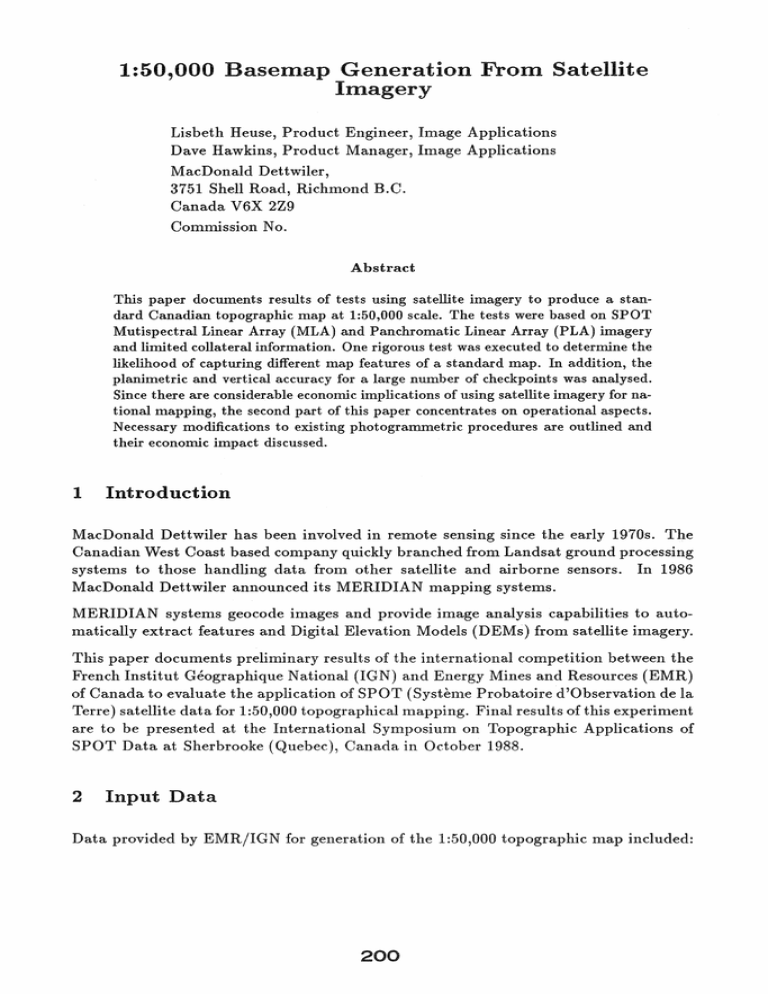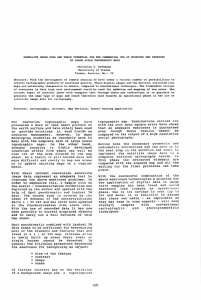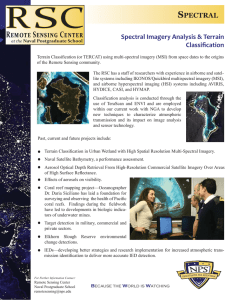Basemap Generation From Satellite Imagery 1:50,000
advertisement

1:50,000 Basemap Generation From Satellite Imagery Lisbeth Heuse, Product Engineer, Image Applications Dave Hawkins, Product Manager, Image Applications MacDonald Dettwiler, 3751 Shell Road, Richmond B.C. Canada V6X 2Z9 Commission No. Abstract This paper documents results of tests using satellite imagery to produce a standard Canadian topographic map at 1:50,000 scale. The tests were based on SPOT Mutispectral Linear Array (MLA) and Panchromatic Linear Array (PLA) imagery and limited collateral information. One rigorous test was executed to determine the likelihood of capturing different map features of a standard map. In addition, the planimetric and vertical accuracy for a large number of checkpoints was analysed. Since there are considerable economic implications of using satellite imagery for national mapping, the second part of this paper concentrates on operational aspects. Necessary modifications to existing photogrammetric procedures are outlined and their economic impact discussed. 1 Introduction MacDonald Dettwiler has been involved in remote sensing since the early 1970s. The Canadian West Coast based company quickly branched from Landsat ground processing systems to those handling data from other satellite and airborne sensors. In 1986 MacDonald Dettwiler announced its MERIDIAN mapping systems. MERIDIAN systems geocode images and provide image analysis capabilities to autoluatically extract features and Digital Elevation Models (DEMs) from satellite imagery. This paper documents preliminary results of the international competition between the French Institut Geographique National (IGN) and Energy Mines and Resources (EMR) of Canada to evaluate the application of SPOT (Systeme Probatoire d'Observation de la Terre) satellite data for 1 :50,000 topographical mapping. Final results of this experiment are to be presented at the International Symposium on Topographic Applications of SPOT Data at Sherbrooke (Quebec), Canada in October 1988. 2 Input Data Data provided by EMR/IGN for generation of the 1:50,000 topographic map included: 200 .. Raw, non-geometrically corrected, CCTs of SPOT scenes (1 oblique MLA at +29 degrees and 2 oblique PLA scenes +29 and -3 degrees) overSherbrooke (Quebec) Canada, covering an area 19.5km x 28km, taken on June 20th 1987 and October 25th 1986 . .. A list, based on the National Topographic Survey (NTS) requirements for 1:50,000 maps, of features to be identified. .. Aerial photographs of features to support operators in image interpretation . .. Approximately 10 Ground Control Points for each SPOT scene to aid in scene orientation and scaling. 3 The Process Rendering raw satellite data suitable for presentation as a 1:50,000 topographic nlap entails a series of processes. Data has to undergo: .. DEM Extraction, .. Geocoding, .. Image Enhancement, .. Manual Topographic Map Data Extraction, and .. Automated Polygon Extraction of Vegetation Areas. 3.1 DEM Extraction Two SPOT PLA scenes were used as input to the DEM extraction process. Automated DEM extraction, as used at MacDonald Dettwiler for this experiment, was a two stage process. The first stage, using lower levels of filtering, resulted in a "coarse DEM". Coarse DEMs were operator checked for quality and corrected for anomalies. They were then used as input to the second, more CPU intensive, stage. The result was an automatically generated DEM in the target resolution. The final DEM was again subjected to operator quality control using visual and image analysis and display techniques. Details of this process are presented at this conference in the paper "Results of A utonlated Digital Elevation Model Generation froin SPOT Satellite Data" by Swann, Kaufflnan and Sharpe. 201 3.2 Geometric Correction Geometric correction for a set of SPOT images was conducted alongside DEM extraction using MacDonald Dettwiler's operational Geocoded Image Correction System (GIeS). There are four levels of geometric correction appropriate to satellite imagery. Firstly, hnagery can be corrected for the effects of the satellite's changing orbital attitude and irregularities. Correction at this level creates an "ideal satellite projection" but leaves perspective distortion. Georeferencing, the next level, corrects for satellite perspective and projects the image as a map. Georeferenced images, being satellite dependent, do not align to a particular coordinate system. It takes geocoding to res ample an image to a standard pixel size, and rotate it to fit the coordinate system of a chosen map projection (for example UTM, Lambert Conformal etc). It is during this step that terrain offset correction is applied to each pixel. Geocoded pixel sizes, being exact multiples of different sensor (MSS, TM, PLA and MLA) resolutions, can be directly overlayed and used with other digital map or geographic information system (GIS) data. 3.3 Image Enhancement MERIDIAN is MacDonald Dettwiler's system for image manipulation and analysis. Depending on the application various functions can be used to enhance an image to its best advantage. For the purposes of this topographic mapping, filtering was used to enhance edges. Resampling fitted the MLA image onto the higher resolution PLA image. Pseudocolouring and Contrast Stretching highlighted urban areas and other regions of demarcation. Density Slicing on MLA band 3 identified water boundaries. Principal COlnponents Analysis and Classification identified vegetation. 3.4 Manual Topographic Map Data Extraction (Point, Linear, Polygon) After image analysis and preparation, features identifiable on the image were manually digitized on screen and recorded into a GIS. Feature types to be identified, as required by the mapping study, included: • Buildings (industrial, residential), • Landcover (wooded, orchards, etc.), • Landforms (eskers), • Hydrography (rivers, strealllS, lakes, swal11ps, etc.), • Roads (2-lane, 4-lane, paved, unpaved), • Structures and utilities (bridges, dams, power lines, etc.), • Railroads and • Designated areas (quarries, ball parks, golf courses, etc.). For later production of thematic nlaps on mylar, each feature type was recorded into a seperate layer of the GIS. In the GIS, together with the occurrence of a feature, was stored a "confidence rating". The confidence rating ranged from 1 to 10. A higher rating suggested a greater degree of certainty in having correctly named and located a feature. 3.5 Automated Topographic Map Data Extraction (Vegetation Polygons) Vegetation polygons, due to their irregular shapes, distribution and extent, represent some of the most difficult boundaries to define in image analysis or Inanual digitization. Automated vegetation polygon extraction, therefore, represents a considerable saving in this otherwise labour intensive task. After automated polygon extraction, MacDonald Dettwiler functions for automatic conversion of raster to vector data, further accelerate efficient data incorporation into GISs. Vegetation identification and classification, for extent and coverage, draws on both spatial and spectral satellite data. The ability to distinguish plant clumps depends on sensor resolution and spectral contrast with surrounding areas. Spectral signatures are used for further physiognomic classification of plants into woody or herbaceous. Broad and needleleaf plants can be differentiated on the basis of reflectance. Spectral changes, visible on temporal imagery, can be used to distinguish between deciduous, semideciduous and evergreen vegetation. Vegetation was classified using traditional monochromatic, true and false colour (pseudocoloured) techniques on the SPOT MLA imagery. Steps for image analysis of multispectral imagery included: • Principal Components Analysis of the bands, • Cluster Analysis of the principal components, • Training or signature modification by the operator, • Generalization of the classified image, • Labeling of the resultant classes. Polygons were extracted from the classified raster image, after operator controlled generalization. Vectorized polygons, generat.ed with a raster to vector program, were then st.ored on a GIS. In instances where the input ilnage is not. t.oo "colnplex" polygon capture can be fully automated. Conlplex scenes may require operator intervention. However, manual digitization using post-classified images is significantly faster than extracting vegetation polygons fronl raw data. 203 3.6 Generalization Trained polygon extraction was used to cover large ground areas in considerable detail. Signatures defined for one area were used, as a first approximation, on adjacent or other areas of satellite coverage. 4 Operational Aspects Until recently, use of satellite imagery for topographic mapping has been limited by the low resolution of available commercial satellite imagery and a number of technical processing problems. Launching of SPOT has made available monochromatic PLA imagery with 10 m ground resolution and MLA multispectral imagery with 20 m ground resolution. Digital processing of satellite imagery has a number of possible advantages over conventional photogrammetric methods for generating geographic information: • Satellite Imagery provides constant global coverage and is available from image archives. • Data acquisition and ground control costs are substantially less than those for equivalent aerial photography, partly due to a decreased need for ground control. • Satellite image data is already in the digital format necessary for computer processing. Computing reduces the labour intensity and, consequently, the costs of map compilation. A mapping project using polar orbiting satellite data has considerations different from those using traditional aerial photo based methods. • In terms of data acquisition the mapping agency has to schedule a "look" from SPOT well in advance. In some cases, captured SPOT data could be useless if the target was obscured by clouds. Meanwhile, waiting for SPOT to be in the appropriate position for another "look" may result in changes of ground spectral data. The pair of images required for DEM extraction, ideally, should be acquired within 14 days of each other. However, for the purposes of this experiment MacDonald Dettwiler successfully extracted DEMs from images captured 8-9 months apart. • Ground truth can be acquired after satellite iInages are available. However, experienc.e at Mac.Donald Dettwiler has shown that for ground control points to be useful in airphoto registration, features Hlust be identifiable in the satellite image. Resolution differences between air photos and satellite images, sOlnetimes make it difficult to correlate points visible on photos onto iInage chips. Useful ground truth points are those consistent with degree of sensor resolution. Location of 204 road intersections and corners of buildings, coupled with some descriptive text, often serve a greater utility in analyzing SPOT images than an air photo showing a particular ground marker. • Work at MacDonald Dettwiler has shown that the number of ground control points needed for a degree of planimetric accuracy is minimal. Details of this work are presented at these proceedings in the paper Sharpe and Wiebe on "Planilnetric Accuracy in Satellite Mapping" . • Collateral ground information is useful to allow signature training for classification. 5 Summary Although the degree of confidence is limited by the double blind nature of the experiment, MacDonald Dettwiler estimates 80% of features required for 1:50,000 topographic mapping were correctly identified and placed. The resultant map is shown on the poster produced for this conference. References [1] P.R. Cooper, D.E. Friedmann, and S.A. Wood. The automatic generation of digital terrain models from satellite images by stereo. Acta Astronautica, 15(3):171-180, 1987. [2] D.E. Friedmann. Operational resampling for correcting images to a geocoded format. In Proceedings of the Fifteenth international symposium on remote sensing of environment, pages 195-212, 1981. [3] David S. Kaufmann and Scott A. Wood. Digital elevation model extraction from stereo satellite images. In Proceedings of the 1987 international geophysical and remote sensing conference, pages 349-352, 1987. [4] Ben Yee. An expert system for planimetric feature extraction. In proceedings of the 1987 international geophysical and remote sensing conference, pages 321-326,1987. 205






